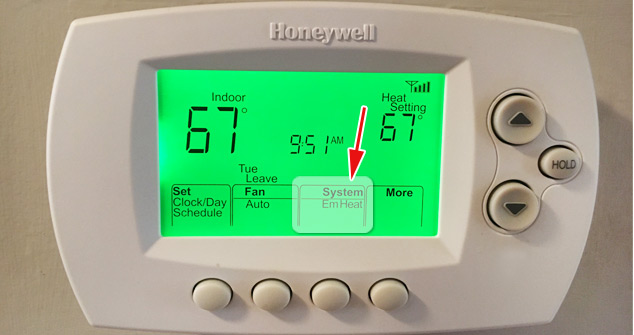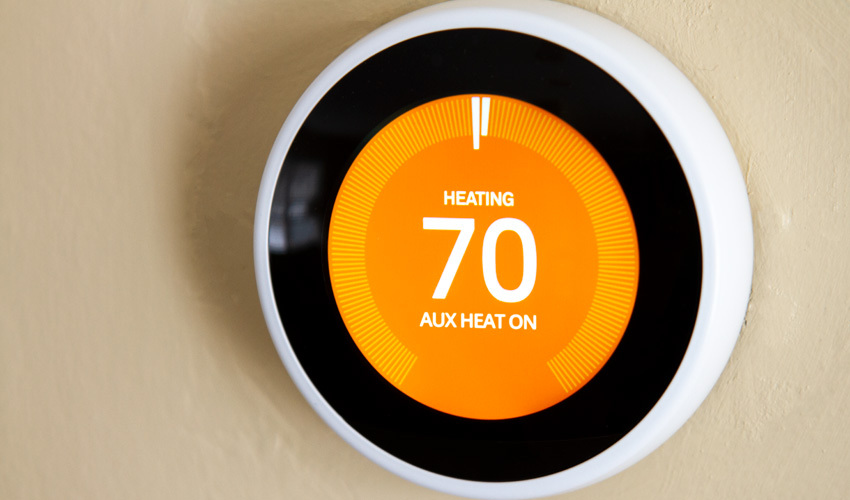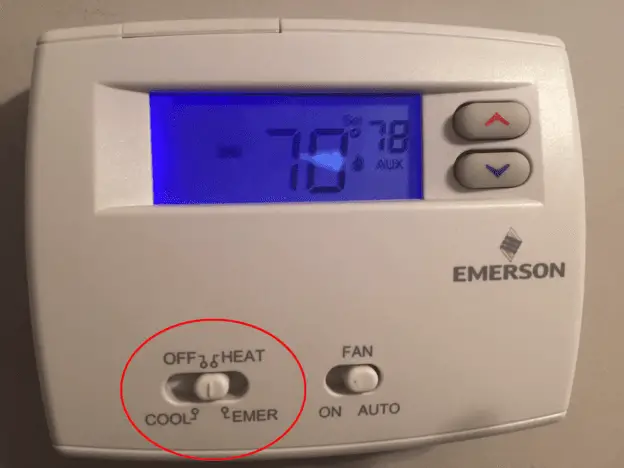Check Best Thermostat Pricing in Amazon
** As an Amazon Associate, I earn from qualifying purchases.
Auxiliary heat helps your home stay warm when it’s very cold. It’s a backup heating system for your thermostat.
Understanding auxiliary heat is important for managing your energy use. When temperatures drop, your main heating system might struggle. Auxiliary heat kicks in to provide extra warmth. This feature is common in heat pumps. These systems work well in mild climates but need help in extreme cold.
Knowing how auxiliary heat works can save you money. It ensures your home stays comfortable without overworking your main system. In this post, we’ll explore what auxiliary heat is, how it functions, and why it’s useful. Get ready to learn how to keep your home warm efficiently.
Introduction To Auxiliary Heat
In winter, heating systems work hard to keep homes warm. Sometimes, the main heating cannot meet the demand. This is where auxiliary heat comes in. Many modern thermostats include an auxiliary heat setting. This setting provides extra warmth when needed.
Purpose Of Auxiliary Heat
Auxiliary heat serves as a backup. It helps the main heating system. When the temperature drops too low, auxiliary heat kicks in. It ensures your home stays comfortable. This feature is important in extreme cold. It prevents the main system from overworking.
When It’s Used
Auxiliary heat activates during very cold weather. If the outside temperature drops below a certain point, it turns on. It also activates when the main system cannot keep up. Rapid temperature drops can trigger it. This ensures your home stays warm and cozy.

Credit: gopaschal.com
How Auxiliary Heat Works
Auxiliary heat on a thermostat provides extra warmth when the main heat pump cannot keep up. It activates automatically during very cold weather or if the heat pump fails. This ensures your home stays comfortable.
Understanding how auxiliary heat works can be a game-changer for maintaining your home’s comfort during winter. When temperatures drop drastically, your regular heating system might struggle to keep up. This is where auxiliary heat steps in. It provides that much-needed boost to ensure your home stays warm and cozy.Mechanism Of Operation
Auxiliary heat activates when your heat pump can’t extract enough warmth from the outside air. This typically happens when temperatures fall below 35 degrees Fahrenheit. Think of it as a backup system. When your thermostat senses the need for extra heat, it automatically switches to auxiliary mode. This mode uses electric resistance heating, which is similar to the heating elements in a toaster. Electric resistance heating is less efficient than a heat pump. It consumes more energy, which can lead to higher electricity bills. However, it’s incredibly effective at providing immediate warmth when you need it most.Integration With Hvac Systems
Auxiliary heat is seamlessly integrated into your HVAC system. It’s designed to work in harmony with your existing heat pump. This integration ensures that your home maintains a consistent temperature even during extreme cold snaps. Your thermostat plays a crucial role in managing this integration. It monitors the temperature and automatically engages the auxiliary heat when necessary. You don’t have to manually switch it on, which is a relief during those cold mornings. You might wonder, “Will this affect my HVAC system’s lifespan?” Not really. Auxiliary heat is designed to kick in only when absolutely needed. It’s a smart feature that ensures your home stays comfortable without overworking your HVAC system. Have you ever noticed your heating system struggling during a particularly cold night? That’s likely when auxiliary heat saved the day. It’s an unsung hero in your thermostat, working silently to keep you warm. Understanding how auxiliary heat works can help you better manage your energy consumption. You can monitor when it’s in use and adjust your primary heating settings accordingly. This way, you can stay warm while keeping your energy bills in check. Do you have any tips or experiences with auxiliary heat that you’d like to share? Your insights could help others make the most out of their HVAC systems.Benefits Of Auxiliary Heat
Auxiliary heat on a thermostat provides several benefits. It helps maintain comfort and improves energy efficiency. In this section, we will explore these advantages in detail.
Enhanced Comfort
Auxiliary heat ensures your home stays warm during cold days. Regular heating systems might struggle when temperatures drop. Auxiliary heat steps in to provide extra warmth. This keeps indoor temperatures stable. No more chilly mornings or cold nights.
Energy Efficiency
Auxiliary heat helps in saving energy. When the main heating system works harder, it uses more power. Auxiliary heat reduces the load on the main system. This leads to lower energy consumption. Over time, this can save money on your energy bills.

Credit: www.aireserv.com
Common Issues With Auxiliary Heat
Auxiliary heat on a thermostat often faces issues like high energy bills and frequent cycling. These problems can lead to inefficient heating and increased wear on the system.
Auxiliary heat can sometimes face issues that affect its performance. These problems can lead to higher energy bills and less comfort. Understanding these common issues can help you fix them quickly.Troubleshooting Tips
First, check if the thermostat is set to the correct mode. Make sure the auxiliary heat is not running when it shouldn’t be. This often happens if the temperature settings are too high. Next, inspect the wiring and connections. Loose or damaged wires can cause malfunctions. If the system runs constantly, there might be a problem with the heat pump. Also, listen for unusual noises. These can indicate mechanical issues that need professional attention.Maintenance Practices
Regular maintenance can prevent many auxiliary heat problems. Clean or replace the air filters monthly. Dirty filters reduce efficiency and can cause overheating. Inspect the outdoor unit for debris or ice. Keep it clean to ensure proper airflow. Schedule annual check-ups with a professional. They can spot and fix issues early. Check the thermostat’s batteries. Weak batteries can cause the system to malfunction. Finally, ensure all vents are open and unblocked. Proper airflow is crucial for efficient heating. “`Choosing The Right Thermostat
Auxiliary heat on a thermostat helps maintain indoor temperature when the main heating system can’t keep up. This feature is vital during extremely cold weather. Understanding how it works ensures efficient heating and reduces energy costs.
When it comes to maintaining a comfortable home temperature, choosing the right thermostat is crucial. A well-chosen thermostat can help you manage your energy usage effectively and ensure your home is always at the perfect temperature. But how do you pick the best one, especially if you use auxiliary heat?Features To Consider
When selecting a thermostat, look for key features that fit your lifestyle. Programmable settings allow you to set different temperatures for different times of the day, optimizing energy use. Wi-Fi connectivity is another great feature. It lets you control your thermostat remotely via your smartphone. This is particularly useful if you’re away from home and want to adjust the temperature. Energy-saving modes can be a game-changer. These modes automatically adjust the temperature to save energy when you’re not home. User-friendly interfaces are also vital. A complicated thermostat can be frustrating. Choose one with a clear display and easy-to-understand controls.Compatibility With Auxiliary Heat
Not all thermostats are compatible with auxiliary heat systems. It’s important to ensure the thermostat you choose can handle this function. Check if the thermostat supports multi-stage heating. Auxiliary heat systems often require this capability to work efficiently. This feature allows the thermostat to manage primary and secondary heating sources seamlessly. Make sure the thermostat has emergency heat settings. This can be a lifesaver during extremely cold weather when your primary heating fails. Consult the thermostat’s manual or the manufacturer’s website for compatibility information. If in doubt, ask a professional to help you choose the right model. Choosing the right thermostat involves more than just picking the first one you see. Consider these features and compatibility points to make an informed decision. What features do you think are essential in a thermostat? Would you prefer a model with advanced settings or something simpler?
Credit: climatecontrolcompany.com
Installation And Setup
Installing and setting up auxiliary heat on a thermostat can seem daunting. But with the right guidance, it becomes a straightforward task. This section will walk you through the process step by step. Whether you choose to do it yourself or hire a professional, this guide will help you understand the essentials.
Step-by-step Guide
First, turn off the power to your HVAC system. This ensures safety during the installation. Next, remove the old thermostat cover. Take note of the wiring configuration or take a picture. This helps in connecting the wires to the new thermostat correctly.
Mount the new thermostat base to the wall. Use screws and anchors if needed. Connect the wires to the corresponding terminals. Typically, the wires will be labeled. If unsure, refer to the thermostat’s manual.
Attach the thermostat cover to the base. Restore power to the HVAC system. Follow the thermostat’s instructions for initial setup. This may include setting the date, time, and temperature preferences.
Check Best Thermostat Pricing in Amazon
** As an Amazon Associate, I earn from qualifying purchases.
Professional Vs. Diy
Hiring a professional can save time and ensure a proper installation. Professionals have the expertise to handle any unexpected issues. They can also provide maintenance tips. This can prolong the life of your HVAC system.
Doing it yourself can be rewarding and cost-effective. It allows you to learn more about your HVAC system. Make sure to read the manual thoroughly. Watch instructional videos if available. Ensure all connections are secure and double-check your work.
Whether you go for professional help or a DIY approach, proper installation is key. It ensures your auxiliary heat functions efficiently. Enjoy a warm and cozy home during those chilly days!
Cost Implications
Understanding the cost implications of auxiliary heat on a thermostat is crucial. It helps you make informed decisions about your heating system. Auxiliary heat can impact both your initial investment and your long-term savings.
Initial Investment
Installing a thermostat with auxiliary heat may require a higher initial investment. These systems often include advanced features. For example, sensors and smart controls. These features enhance efficiency and comfort but come at a higher cost. You may also need a professional installation. This ensures the system functions correctly. This adds to the initial expenses.
Long-term Savings
Despite the higher initial cost, auxiliary heat can offer long-term savings. It reduces the strain on your primary heating system. This can extend the life of your main system. Auxiliary heat can also be more efficient in extreme cold. This results in lower energy bills. Using auxiliary heat only when needed can keep costs down. Programmable thermostats help manage this efficiently. Over time, these savings can offset the initial investment.
Future Of Auxiliary Heat
As we look towards the future of auxiliary heat, we see a world where technology and sustainability go hand in hand. Advancements in smart home systems and eco-friendly practices are changing the way we think about heating our homes. Let’s dive into what the future holds for auxiliary heat on your thermostat.
Technological Advancements
The future of auxiliary heat is bright with technological advancements. Smart thermostats are becoming increasingly sophisticated, learning your habits and adjusting automatically. Imagine a thermostat that knows when you’re on your way home and starts heating your house just in time for your arrival.
Additionally, integration with other smart home devices is on the rise. Your thermostat can now communicate with your phone, lights, and even your coffee maker. This interconnectedness ensures that your home is not only warm but also energy-efficient.
Sustainable Practices
Auxiliary heat is also moving towards more sustainable practices. With the rise of renewable energy sources, like solar and wind, you can now power your heating system in an eco-friendly way. This shift not only reduces your carbon footprint but also lowers your energy bills.
Furthermore, advances in insulation and home design play a significant role. Better-insulated homes require less auxiliary heat, making your entire heating system more efficient. Have you considered upgrading your insulation to save on heating costs?
In conclusion, the future of auxiliary heat is exciting and full of potential. With technological advancements and sustainable practices, you’ll have a more comfortable and efficient home. What are you most excited about in the future of home heating?
Frequently Asked Questions
Should My Thermostat Be On Auxiliary Heat?
Use auxiliary heat during extremely cold weather when the primary heat can’t maintain the desired temperature.
Is It Ok To Run Auxiliary Heat?
Yes, it’s OK to run auxiliary heat. It helps maintain comfort during extremely cold weather. Use it when your main heating system struggles to keep up.
Why Does My Heat Keep Saying Auxiliary Heat?
Your heat says auxiliary heat because the primary system can’t maintain the desired temperature. This usually happens in extreme cold.
Is Auxiliary Heat More Expensive?
Yes, auxiliary heat is typically more expensive. It uses more energy than your primary heating system, increasing costs.
Conclusion
Understanding auxiliary heat on a thermostat is crucial for home comfort. This feature provides extra warmth during cold snaps. It ensures your home stays cozy when the main system struggles. Proper usage can also prevent high energy bills. Regular maintenance of your heating system helps efficiency.
Clear knowledge of auxiliary heat aids in better thermostat management. Stay warm, save energy, and keep your home comfortable.
Check Best Thermostat Pricing in Amazon
** As an Amazon Associate, I earn from qualifying purchases.


